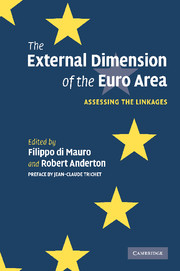Book contents
- Frontmatter
- Contents
- List of illustrations
- List of contributors
- Preface by Jean-Claude Trichet
- 1 Introduction
- 2 The external dimension of the euro area: stylised facts and initial findings
- 3 Product variety and macro trade models: implications for the new EU Member States
- 4 Exchange-rate pass-through to import prices in the euro area
- 5 The international equity holdings of euro area investors
- 6 Global linkages through foreign direct investment
- 7 Shocks and shock absorbers: the international propagation of equity market shocks and the design of appropriate policy responses
- 8 The euro area in the global economy: its sensitivity to the international environment and its influence on global economic developments
- Index
- References
8 - The euro area in the global economy: its sensitivity to the international environment and its influence on global economic developments
Published online by Cambridge University Press: 22 September 2009
- Frontmatter
- Contents
- List of illustrations
- List of contributors
- Preface by Jean-Claude Trichet
- 1 Introduction
- 2 The external dimension of the euro area: stylised facts and initial findings
- 3 Product variety and macro trade models: implications for the new EU Member States
- 4 Exchange-rate pass-through to import prices in the euro area
- 5 The international equity holdings of euro area investors
- 6 Global linkages through foreign direct investment
- 7 Shocks and shock absorbers: the international propagation of equity market shocks and the design of appropriate policy responses
- 8 The euro area in the global economy: its sensitivity to the international environment and its influence on global economic developments
- Index
- References
Summary
Introduction
External developments affect the euro area through a variety of transmission channels. While trade remains the predominant source of linkages between the euro area and the rest of the world, several studies show that other channels, notably financial markets, play an increasingly important role in the transmission of shocks and spillover effects to the euro area.
The degree of exposure of a country to the international environment is traditionally measured by its trade-openness ratio. It is generally assumed that relatively-closed countries are rather immune from developments abroad, since in their case the trade channel is expected to play a limited role in the transmission of external shocks to domestic variables. Besides, it is often assumed that a country's sensitivity to external developments varies depending on its geographical trade structure. However, such measures of external exposure may be misleading as they can only capture the effect via direct trade of a shock. Beyond this direct effect, there are additional channels – third-market, second-round and spillover effects – through which economies are indirectly affected by the original shocks. Moreover, given increasing financial development and integration, financial markets have gained influence in the transmission of shocks across countries.
The purpose of this chapter is to assess the strength of international linkages using the extension by Dees et al. (2005, hereafter DdPS) of the Global Vector Auto-Regressive (GVAR) approach proposed by Pesaran et al. (2004).
- Type
- Chapter
- Information
- The External Dimension of the Euro AreaAssessing the Linkages, pp. 173 - 201Publisher: Cambridge University PressPrint publication year: 2007



